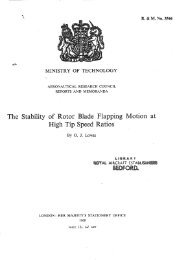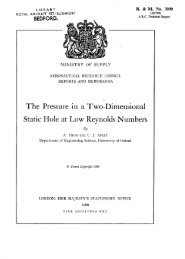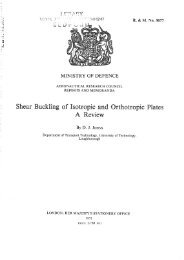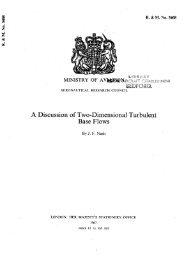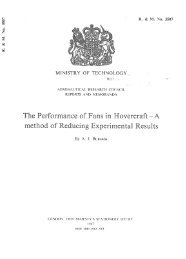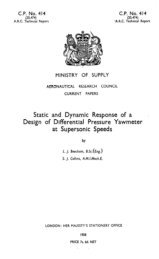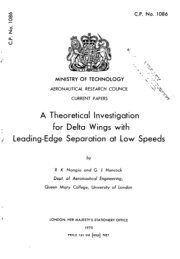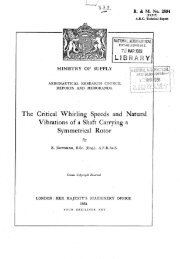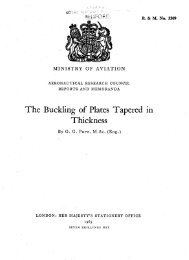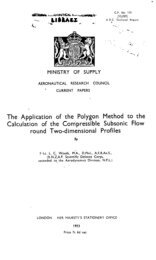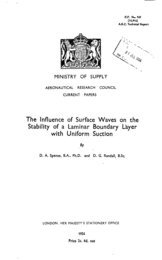Fatigue behaviour of BS 2L65 aluminium alloy pin - aerade
Fatigue behaviour of BS 2L65 aluminium alloy pin - aerade
Fatigue behaviour of BS 2L65 aluminium alloy pin - aerade
You also want an ePaper? Increase the reach of your titles
YUMPU automatically turns print PDFs into web optimized ePapers that Google loves.
8<br />
the fatigue life <strong>of</strong> a lug. Theoretical analysis <strong>of</strong> the interference fit case is<br />
difficult, so it was decided to make direct measurements on the lug using the<br />
Companion Specimen Method 7.<br />
3. I Method <strong>of</strong> measurement<br />
Briefly, the Companion Specimen Method consists <strong>of</strong> reproducing on a plain<br />
specimen the stress and strain history at a position <strong>of</strong> stress concentration on<br />
another specimen. A strain gauge is attached at the point <strong>of</strong> interest in the<br />
latter specimen, generally where the fatigue crack is likely to start, and the<br />
strain history is recorded whilst the specimen is subjected to the desired load<br />
sequence. The recorded strain sequence is then applied to a plain specimen,<br />
made <strong>of</strong> the same material as the component, and by measuring the loads applied,<br />
the corresponding stress history in the component is determined.<br />
3.2 Material aud s~ecimens<br />
All lug and plain specimens were cut from 2 bars <strong>of</strong> <strong>BS</strong> <strong>2L65</strong> <strong>aluminium</strong><br />
<strong>alloy</strong> from the same melt as those used in the fatigue test programme. The lug<br />
specimen is shown in Fig 18 and the bush <strong>of</strong> $80 steel material in Fig 19. At<br />
one end <strong>of</strong> the lug the hole was enlarged to accept a bush having a 0.27%<br />
(0.076 ram) diametral interference, to be loaded by a 25.4 mm diameter <strong>pin</strong>. The<br />
other end was machined to take the <strong>pin</strong> alone without the bush to enable a direct<br />
comparison to be made between a bushed hole and an equivalent unbushed hole.<br />
Thus the specimen represented exactly the bushed and unbushed lugs used in the<br />
fatigue test programme. The strain gauges in both holes were placed as shown<br />
in Fig 18, mid-way through the thickness <strong>of</strong> the lug. In order to clear the<br />
gauge the bush had a hole drilled in its centre and was split, half being<br />
inserted from each side, see Fig 19. The gauge was attached to the lug before<br />
inserting the bush, in this way the strain due to the bush alone could be<br />
measured. The loading <strong>pin</strong>s had a slot milled along their length to accommodate<br />
the gauge leads in the bushed hole, and both the gauge and its leads in the<br />
unbushed hole. The plain specimen is shown in Fig 20.<br />
3.3 Summarry <strong>of</strong> t_ ests carried_~out.<br />
The load sequences employed, shown in Fig 21, were designed to represent,<br />
in a simple way, the essential features <strong>of</strong> the fatigue tests reported in<br />
section 2, as it was hoped that the Companion Specimen data could be used to aid<br />
interpretation <strong>of</strong> the fatigue test results.



